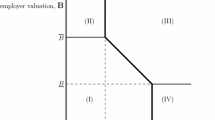Abstract
The purpose of this paper is to establish a new insight into the potential benefit of fringe benefits used by firms in compensation contracts. We show that fringe benefits have a role to provide incentives and reduce agency costs. In an agency model with moral hazard, we examine the optimal incentive package that involves salary, equity shares, and fringe benefits. Based on the notion that fringe benefits are imperfect substitutes for salary and (weakly) complementary to effort, we show how the optimal package may include an excessive provision of fringe benefits that exceeds the first-best level, and why it involves a distortion towards overconsumption of fringe benefits in terms of the manager's preferences.
Similar content being viewed by others
References
Akerlof, G. A. (1982): “Labor Contracts as Partial Gift Exchange”.Quarterly Journal of Economics 97: 543–569.
Dye, R. A., and Antle, R. (1984): “Self-selection via Fringe Benefits”.Journal of Labor Economics 2: 388–411.
Grossman, S. J., and Hart, O. D. (1983): “An Analysis of the Principal-Agent Problem”.Econometrica 51: 7–45.
Harris, M., and Raviv, A. (1979): “Optimal Incentive Contracts with Imperfect Information”.Journal of Economic Theory 20: 231–259.
— (1991): “The Theory of Capital Structure”.Journal of Finance 46: 297–355.
Hart, O. D., and Holmström, B. (1987): “Theory of Contracts”. InAdvances in Economic Theory (Econometric Society Monographs, Fifth World Congress), edited by T. Bewley. New York: Cambridge University Press.
Haugen, R. A., and Senbet, L. W. (1981): “Resolving the Agency Problems of External Capital through Options”.Journal of Finance 36: 629–647.
Hemmer, T. (1993): “Risk-free Incentive Contracts”.Journal of Accounting and Economics 16: 447–473.
Holmström, B. (1979): “Moral Hazard and Observability”.Bell Journal of Economics 10: 74–91.
Holmström, B., and Milgrom, P. R. (1991): “Multitask Principal—Agent Analysis: Incentive Contracts, Asset Ownership, and Job Design”.Journal of Law, Economics and Organization V7, Special Issue: 29–52.
Keeney, R. L. (1973): “Risk Independence and Multiattributed Utility Functions”.Econometrica 41: 27–34.
Jensen, M. C., and Meckling, W. H. (1976): “Theory of the Firm: Managerial Behavior, Agency Costs and Ownership Structure”.Journal of Financial Economics 3: 305–360.
Jewitt, I. (1988): “Justifying the First-order Approach to Principal—Agent Problems”.Econometrica 56: 1177–1190.
Milgrom, P. R. (1981): “Good News and Bad News: Representation Theorems and Applications”.Bell Journal of Economics 13: 380–391.
Mirrlees, J. A. (1971): “An Exploration in the Theory of Optimum Income Taxation”.Review of Economic Studies 38: 175–208.
— (1975): “The Theory of Moral Hazard and Observable Behavior: Part 1”. Working Paper, Nuffield College, University of Oxford, Oxford.
— (1976): “The Optimal Structure of Incentives and Authority within an Organization”.Bell Journal of Economics 7: 105–131.
Pollak, R. A. (1967): “Additive von Neumann-Morgenstern Utility Functions”.Econometrica 35: 485–494.
Rogerson, W. P. (1985): “The First-order Approach to Principal—Agent Problems”.Econometrica 53: 1357–1367.
Ross, S. A. (1973): “The Economic Theory of Agency: the Principal's Problem”.American Economic Review 63: 134–139.
Sappington, D. (1983): “Limited Liability Contracts between Principal and Agent”.Journal of Economic Theory 29: 1–21.
Selender, A., and Zou, L. (1994): “Limited Liability and the Underlying-asset Constraint: on the Use of Share-derivative Contracts to Resolve Agency Problems”.Journal of Economics/Zeitschrift für Nationalökonomie 59: 149–166.
Shavell, S. (1979): “Risk Sharing and Incentives in the Principal and Agent Relationship”.Bell Journal of Economics 10: 55–73.
Author information
Authors and Affiliations
Rights and permissions
About this article
Cite this article
Zou, L. Incentive roles of fringe benefits in compensation contracts. Zeitschr. f. Nationalökonomie 65, 181–199 (1997). https://doi.org/10.1007/BF01226934
Received:
Revised:
Issue Date:
DOI: https://doi.org/10.1007/BF01226934




